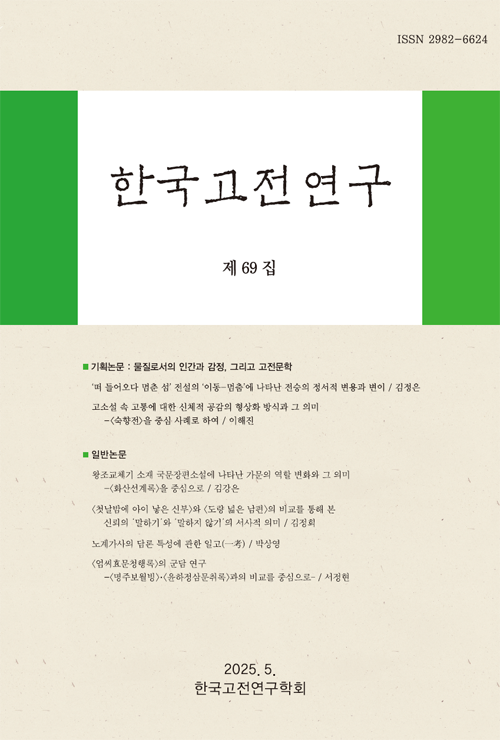- 영문명
- The Process and Meaning of Bereavement and Mourning in the Kang Eul-saeng Version of Heoungaegibonpuri - In Comparison with the Mother-Daughter Relationship in the Film Wonderland (2024)
- 발행기관
- 한국고전연구학회
- 저자명
- 김지혜(Ji-hye Kim)
- 간행물 정보
- 『한국고전연구(韓國古典硏究)』제70권, 33~60쪽, 전체 28쪽
- 주제분류
- 인문학 > 문학
- 파일형태
- 발행일자
- 2025.08.31

국문 초록
본 연구는 멜라니 클라인의 망상분열적 위치와 우울적 위치 개념을 바탕으로 강을생본 <허웅애기본풀이>에 나타난 사별 애도 과정의 특징을 분석하였다. 강을생본 <허웅애기본풀이>는 어린 시절 친모의 죽음을 겪은 딸이 상실을 심리적으로 통합하지 못한 채 어머니가 되어 다시 상실을 맞이하면서 애도가 유예되고 대물림되는 심리 구조를 드러낸다. 이승과 저승이 단절로 끝맺는 결말은 산 자가 망자를 떠나보내야 한다는 사실을 환기하지만 망자를 내면의 지지 자원으로 통합하는 단계까지는 보여주지 못한다.
한편, 유사한 상실 경험을 다룬 영화 <원더랜드>는 AI 기술을 통한 망자와의 재회가 남겨진 자를 환상 속에 머무르게 할 위험성을 보여주면서도 동시에 일정한 전환점을 마련한다. AI 바이리의 존재는 딸 바이지아로 하여금 처음에는 상실을 회피하게 하지만 물리적 접촉의 불가능성과 엄마의 죽음 고백 수용을 통해 망상분열적 위치를 통과하도록 이끈다. AI를 통한 재현은 우울적 위치로의 완전한 이행을 보장하지는 않지만 환상과 그 깨짐이 교차하는 모순적 계기를 제공한다고 할 수 있다.
두 작품은 죽은 자의 현존이 애도 과정에 미치는 영향을 탐색하며, 부재를 상징적으로 통합하지 못했을 때 발생하는 심리적 문제를 공통적으로 드러냈다. 그러나 <허웅애기본풀이>는 이승과 저승의 단절이라는 서사적 결말을 통해 환상적 재현이 아닌 단절의 수용이 애도 과정의 핵심임을 강조한다. 더 나아가 굿이라는 의례적 맥락에서 이 서사가 다시 연행될 때, 미완의 애도 여정을 재소환하고 이승과 저승을 상징적으로 연결할 수 있는 가능성도 제시한다. 이는 오늘날 AI 기술 중심의 애도 방식에 중요한 시사점을 제공한다고 할 수 있다.
영문 초록
This study analyzes the characteristics of the bereavement and mourning process depicted in Heoungaegibonpuri(Kang Eul-saeng version) through the lens of Melanie Klein’s concepts of the paranoid-schizoid and depressive positions. The narrative reveals a psychological structure of deferred and transgenerational mourning, as the daughter, who experienced the death of her biological mother in childhood, becomes a mother herself and faces loss once again without having psychologically integrated the initial trauma. The ending, in which the world of the living and the world of the dead are severed, evokes the necessity of letting the deceased go, but it falls short of guiding the living toward internalizing the dead as a source of psychological support.
In parallel, the film Wonderland, which deals with a similar experience of loss, highlights the potential danger of AI-mediated reunions in impeding the bereaved's confrontation with reality and keeping them trapped in illusion. Both works explore the influence of the deceased’s continued “presence” on the mourning process and point to the consequences that arise when psychological integration of absence is not achieved.
However, Heoungaegibonpuri presents the ritual of gut as a means of reconnecting severed ties between the living and the dead, suggesting the possibility of completing an unfinished mourning process. The gut serves as a transformative space in which the deceased can be symbolically internalized, allowing the mourner to recover their vitality. This traditional mechanism of grief carries important implications for contemporary, AI-centered approaches to mourning.
목차
1. 서론
2. 강을생본 <허웅애기본풀이>가 던지는 화두: 유예된 애도의 대물림
3. 굿 연행과 AI 기술을 통한 우울적 위치의 통과 시도
4. 결론
참고문헌
키워드
해당간행물 수록 논문
참고문헌
최근 이용한 논문
교보eBook 첫 방문을 환영 합니다!

신규가입 혜택 지급이 완료 되었습니다.
바로 사용 가능한 교보e캐시 1,000원 (유효기간 7일)
지금 바로 교보eBook의 다양한 콘텐츠를 이용해 보세요!



